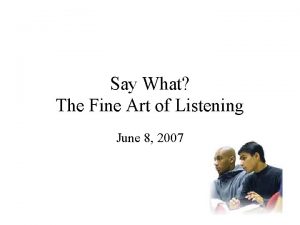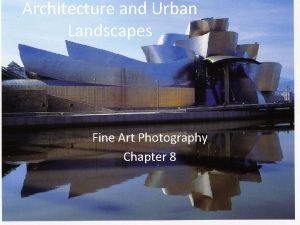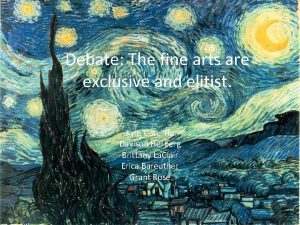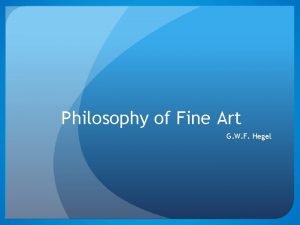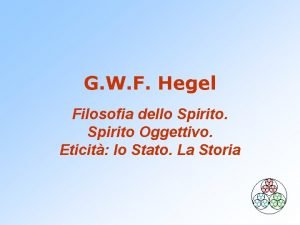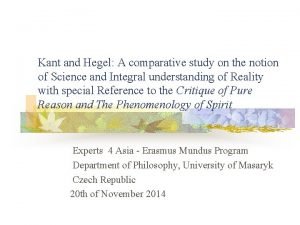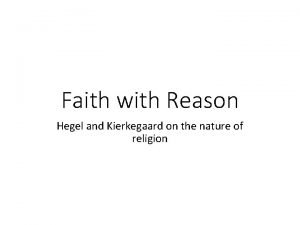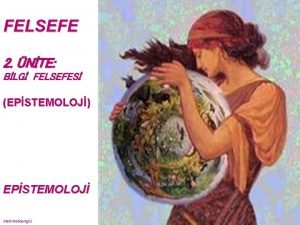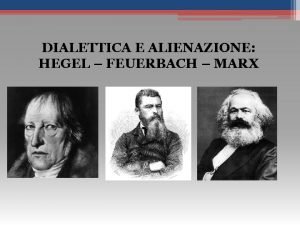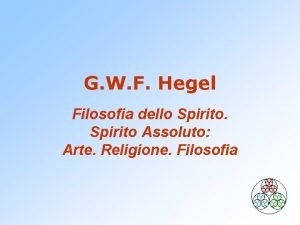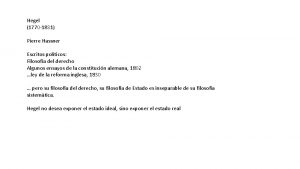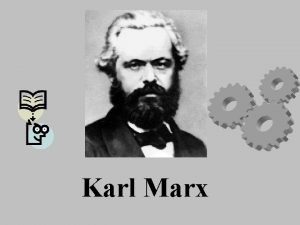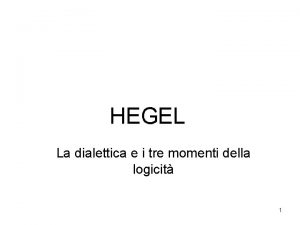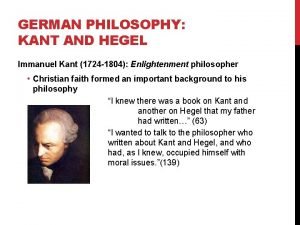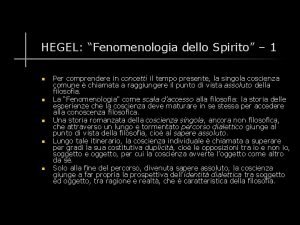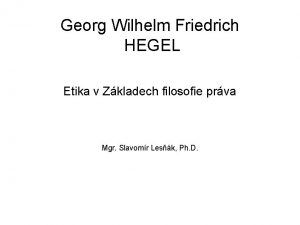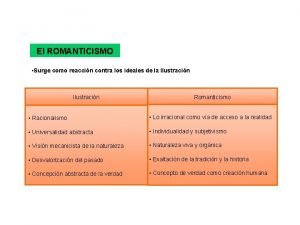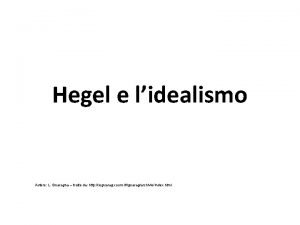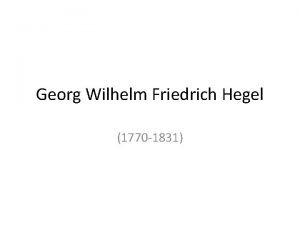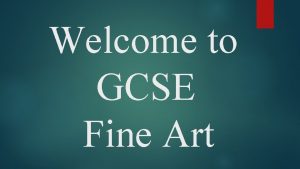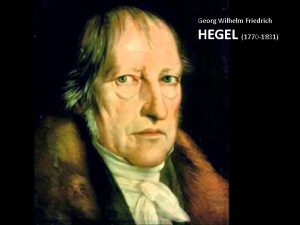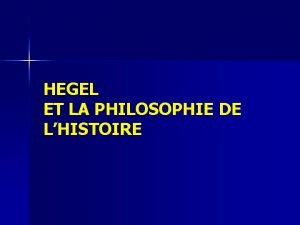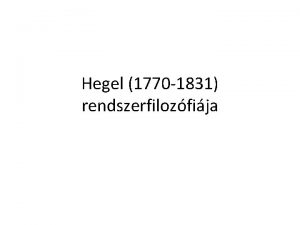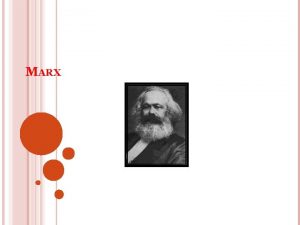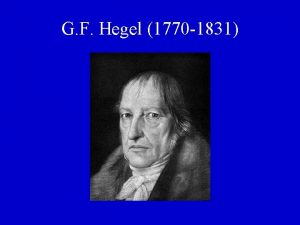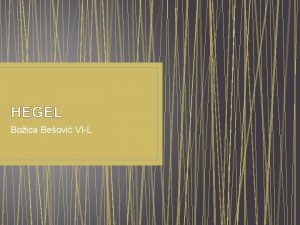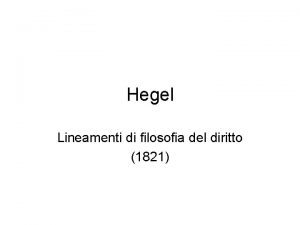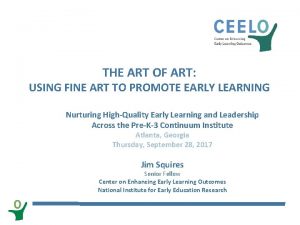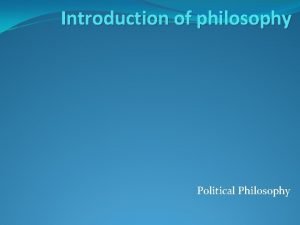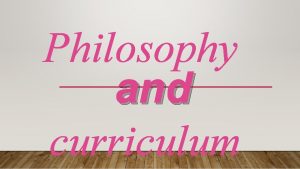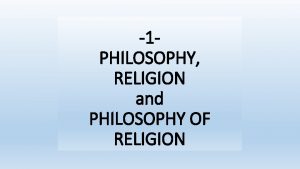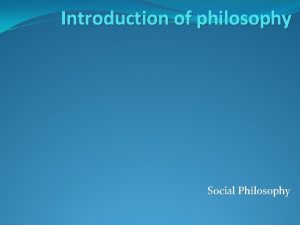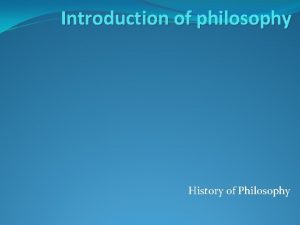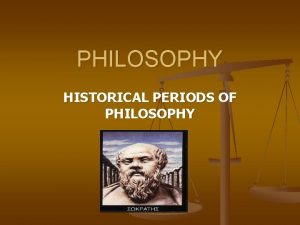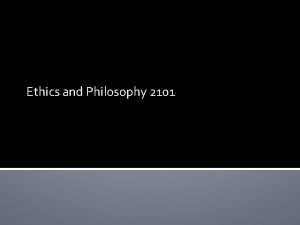Hegel Philosophy of Fine Art Hegel was the








































- Slides: 40

Hegel Philosophy of Fine Art Hegel was the most important German philosopher of the early 19 th century. His allembracing Absolute Idealism had immense influence on later thinkers, his writings providing what is arguably the most systematic and comprehensive aesthetic theory. Georg Wilhelm Friedrich Hegel (1770 -1831) Portrait by Jakob Schlesinger, 1831 “It would be only a slight exaggeration to say that every philosophical aesthetician in the nineteenth and twentieth centuries has been either a Kantian or a Hegelian” (Shapiro, 1992, 182).

Kant’s Aesthetics Hegel’s Aesthetics Kantian aesthetics focuses: Hegelian aesthetics emphasizes: 1) on those characteristics of aesthetic experience that differentiate it from others (from knowledge and action)—the aesthetic as a separate realm from theoretical and practical 1) meaning and content in works of art 2) the best works of art are those that have as their content the most concrete and fully articulated idea 2) on the contemplation of form as the defining characteristic of the aesthetic Yet Hegel’s aesthetics would not have been possible without Kant and for post-Kantian Romanticism (Schelling and the Schlegal brothers) which emphasized art and beauty as providing our most profound access to reality.

Post-Kantian Romanticism The Phenomenal World The Noumenal World Reality that appears to human consciousness Reality as it is in-itself The world that shows up for us is going to be determined by the instrument of the human mind. Science provides knowledge only of the phenomenal world. The universality, or objectivity, of scientific judgments is based on the universality of ‘forms of sensibility’ and the ‘categories of the understanding’ of the human mind. Space and Time are ‘forms of our sensibility’ and these are “the nets within which we catch whatever we perceive, and those categories of understanding are the framework within which we make intelligible to ourselves whatever it is that our senses pick up” (Magee 2001, 135). Kant opens the door to Romanticism in The Critique of Judgment in suggesting that perhaps art and aesthetic experience can provide insight into the deeper truth of reality as it is in-itself. “Yet at the same time and on that very account the judgment has validity for everyone (though, of course, for each only a singular judgment immediately accompanying his intuition), because its determining ground lies perhaps in the concept of that which may be regarded as the supersensible substrate of humanity” (Kant 1994, 135).

The Tübingen Three Georg Wilhelm Friedrich Hegel (1770 -1831) Johann Christian Friedrich Hölderlin (1770 -1843) Friedrich Wilhelm Joseph Schelling (1775 -1854) Classmates and roommates at Tübinger Stift, the seminary of the University of Tübingen in the late 1790 s.

Hegel and Romanticism Hegel’s early writings show him to be a participant in the development of Romanticism along with his friends Hölderlin and Schelling. In Romanticism, art, aesthetic experience, and the faculty of imagination, have a higher role than ever before considered in the history of Western thought since Plato. Schelling would emphasize the need for philosophy to become art. In a similar way, Hegel speaks of the need for philosophy to become poetic and poetry to become philosophical. By the time of The Phenomenology of the Spirit (1807), however, Hegel had become a critic of this Romantic aestheticism. His mature philosophy shows a Romanticist influence; and yet, he breaks with Romanticism in turning to reason and philosophy rather than art as a source of knowledge. Nevertheless the Phenomenology contains some of the most significant philosophical writings of the arts—a speculative analysis of tragedy, and a theory of the development and dissolution of Greek art. The Phenomenology can be read as a contest between the claims of art and those of philosophical science, and while Hegel’s allegiance finally comes down on the side of science, recent philosophers like Derrida have pointed out that Hegel’s text is less scientific and more artistic than he thought.

Hegel and the Arts Hegel later lectured periodically on aesthetics, and the text, Aesthetics: Lectures on Fine Art (1835), from which our selection is taken, is a collection of various student transcripts of his lectures and some of his manuscript notes for these lectures. More than any other previous philosopher Hegel took a comprehensive and many-sided interest in the arts. He traveled to many galleries and read extensively in literatures of the world. He took a passionate interest in the opera and befriended a number of actors; nevertheless, he announced his controversial “end of art” thesis.

The End of Art Poetry is the universal art of the spirit (Geist) which has become free in itself and which is not tied down for its realization to external sensuous material; instead, it launches out exclusively in the inner space and the inner time of ideas and feelings. Yet, precisely, at this highest stage, art now transcends itself, in that it forsakes the element of a reconciled embodiment of the spirit in sensuous form and passes over from the poetry of the imagination to the prose of thought. (Hegel, 1994, 158).

The End of Art, considered in its highest vocation, is and remains for us a thing of the past. Thereby it has lost for us genuine truth and life, and has rather been transferred into our ideas instead of maintaining its earlier necessity in reality and occupying its higher place. What is now aroused in us by works of art is not just immediate enjoyment, but our judgment also, since we subject to our intellectual consideration (i) the content of art, and (ii) the work of art's means of presentation, and the appropriateness or inappropriateness of both to one another. The philosophy of art is therefore a greater need in our day than it was in the days when art by itself yielded full satisfaction. Art invites us to intellectual consideration, and that not for the purpose of creating art again, but for knowing philosophically what art is. (Hegel 1975, 11)

Kant’s Transcendental Idealism The Phenomenal World The Noumenal World Reality that appears to human consciousness Reality as it is in-itself The world that shows up for us is going to be determined by the instrument of the human mind. . The world as it is in-itself is “transcendental” in that it cannot be registered in experience.

Hegel’s Absolute Idealism The Phenomenal World Reality that appears to human consciousness Hegel followed Kant in accepting that reason gives us knowledge of the Phenomenal World, the world as it appears as a phenomenon in consciousness. However, he rejects Kant’s assumption (shared by the prior tradition) of a Noumenal World, a world as it is in-itself, apart from how it appears in human consciousness. In other words, the world just is as it appears as a phenomenon of human consciousness. There simply is no point of talking about a world as it is initself. Thus Hegel’s is a “holistic worldview in which consciousness and the world are not separate but inseparably integrated” (Solomon 2005, 291).

Hegel’s Absolute Idealism The Phenomenology of Spirit (1807) At first glance, Hegel’s point that the world just as it is appears as a phenomenon of human consciousness, might seem to imply the most pernicious relativism, the view that the world is radically different for different human consciousnesses with no way of evaluating one worldview as better than another. But, for Hegel, all individual consciousnesses are a manifestation of the Absolute—Spirit or Mind realizing itself through human consciousness. His masterwork, die Pha nomenologie des Geistes (1807), translated as Phenomenology of Spirit or Phenomenology of Mind, traces the development of a process of Self-realization of Geistes through human consciousness. [“What Geist means is midway between spirit and mind—its connotations are more mental than the English word “spirit, ” and more spiritual than the English word “mind” (Magee 2001, 159). ]

Hegel’s Absolute Idealism The Phenomenology of Spirit (1807) In The Phenomenology of Spirit, Hegel proposes to begin from a position without presuppositions in order to examine consciousness from the inside, as it appears to itself. A phenomenology of Geistes is an exposition of knowledge as a phenomenon as it actually appears in consciousness. Hegel thus “suggests that we give up the view that the self is essentially a feature of the individual: the self—or ‘Spirit’—is shared by all of us” (Solomon 2005, 291). We all participate in the unfolding of Spirit through history. Hegel’s philosophy is thus an all-encompassing system which “sought to relate and unify man and nature, spirit and matter, human and divine, time and eternity” (Tarnas 1991, 379).

Hegel’s Absolute Idealism The Phenomenology of Spirit (1807) Hegel referred to his philosophy as an “Absolute Idealism, ” in contrast to Kant’s “Transcendental Idealism. ” Reality, for Hegel, is simply the product of this Absolute Spirit moving through history. The development of human history, then, is regarded as a series of successive stages of Spirit’s journey toward Self-realization. Thus any particular worldview is not just as valid as any other (the pernicious relativism). Any particular worldview is thus measured by its place in history, its place in the development of Spirit’s Self-realization. “The way we view the world is already determined by our place in history, our language, and our society” (Solomon 2005, 292). “For Hegel Geist is the very stuff of existence, the ultimate essence of being; and the entire historical process that constitutes reality is the development of Geist towards self-awareness and self-knowledge. When this state is reached, all that exists will be harmoniously at one with itself. Hegel called this self-aware one-ness of everything ‘the Absolute. ’ Because he viewed the essential stuff of what exists as something non-material his philosophy became known as ‘Absolute Idealism’” (Magee 2001, 159)

Hegel’s Absolute Idealism The Phenomenology of Spirit (1807) Plato once referred to the ancient battle of the giants concerning being, and in this he was referring to the difference between two Pre-Socratic philosophers, Heraclitus and Parmenides. Whereas Heraclitus thought that everything is changing, Parmenides argued that change is an illusion and reality is unchanging. Breaking with the tradition of philosophy since Plato, Hegel sides with Heraclitus in his view that reality is constantly changing. Hegel introduces into modern philosophy the notion that reality is historical; each worldview thus emerges within a particular historical context. “He saw everything as having developed. Everything that exists is the outcome of a process; and therefore, he thought, understanding in any broad area of reality always involves understanding a process of change” (Magee 2001, 159).

Hegel’s Absolute Idealism The Phenomenology of Spirit (1807) Hegel thought he understood how the process of history worked. His famous account of this process is called the “dialectic” of history. “He went on to claim that change is always intelligible, never merely arbitrary. Every complex situation contains within itself conflicting elements, he believed, and these are destabilizing. Therefore no such situation can just continue indefinitely. The conflicts have to work themselves out, until they achieve resolution, and this will then constitute an new situation—and of course a situation that contains new conflicts. This, in Hegel’s view, is the rationale of change; and he produced a vocabulary to describe it. The process as a whole he called the dialectical process, or just the dialectic” (Magee 2001, 159). The word ‘dialectic’ is etymologically related to the word ‘dialogue. ’ In Plato we have the ‘dialectic’ as a process of dialogue, “a conversation between two people who, starting from opposing perspectives on an issue, eventually arrive at a position that preserves the insights of each” (Guignon & Pereboom 2001, 3).

Hegel’s Absolute Idealism The Phenomenology of Spirit (1807) Hegel’s dialectic develops according to a three stage pattern, from thesis to antithesis to synthesis. “The description of the first stage, the initial state of affairs, whatever it is, is thesis. The reaction that this always provokes, the countervailing forces, the conflicting elements, are described by him as the antithesis of thesis. The conflict between the two eventually resolves itself into a new situation which sheds elements of both but also retains elements of both, and this is called the synthesis. But because the synthesis is a new situation it contains new conflicts, and therefore becomes the beginning of a new triad of thesis, antithesis, synthesis. And so the process of change goes on being seamlessly woven, always evolving further change out of itself. This, says Hegel, is why nothing ever stays the same. It is why everything—ideas, religion, the arts, the sciences, the economy, institutions, society itself—is always changing, and why in each case the pattern of change is dialectical” (Magee 2001, 159). The antithesis emerges as a negation of thesis, and thus the next stage, the synthesis, is a negation of the negation. This synthesis involves a special double movement of both canceling and uniting. Hegel uses the verb aufheben which has several seemingly contradictory meanings, including "to lift up", "to abolish", "cancel" or "suspend", or "to sublate". As Hegel explains, “it signifies conserving, preserving, and at the same time also making cease, making an end” (Hegel 1966, 181).

Hegel’s Absolute Idealism The Phenomenology of Spirit (1807) Synthesis Antithesis The antithesis emerges as a negation of thesis, and thus the next stage, the synthesis, is a negation of the negation. This development from thesis to antithesis to synthesis involves a special double movement of both canceling and uniting. Hegel uses the verb aufheben which has several seemingly contradictory meanings, including "to lift up", "to abolish", "cancel" or "suspend", or "to sublate". As Hegel explains, “it signifies conserving, preserving, and at the same time also making cease, making an end” (Hegel 1966, 181).

Hegel’s Absolute Idealism The Phenomenology of Spirit (1807) The dialectical process of history unfolds in a kind of ascending spiral, toward Absolute Spirit’s final selfawareness of itself.

Hegel’s Philosophy of Art The Phenomenology of Spirit (1807) In the Phenomenology, in the sections titled ‘Natural religion’ and ‘The religion of art, ’ Hegel develops a complex account of the dialectic of the production of reception of artworks in which the meaning of the work of art is a function of the relation between the artist, the artwork, and the audience. He provides a narrative account of how art first emerges from a more mechanical craft. In this analysis those who admire a finished work do not really comprehend it if they focus only on its surface beauty or form and fail to grasp the thought, activity and labor that the artist put into the work. Here we see his departure from Kant’s focus on the form of the work of art.

Hegel’s Philosophy of Art The Phenomenology of Spirit (1807) Hegel was critical of a tradition in German thought that included Kant which regarded Greek sculpture as an unsurpassable model. On Hegel’s analysis this art was a failure despite its beauty. Here Hegel turned toward work that aim at collapsing the distinction between artist and audience, such works of ‘living art’ like hymns, or Dionsysian revels. Just as Kant’s notion of ‘abstract art’ anticipates minimalist art in the 20 th century, Hegel’s discussion of ‘living art’ anticipates 20 th century developments like participatory theater and art ‘happenings. ’ But the problem with this ‘living art, ’ according to Hegel, is that it fails to achieve a fully conscious wholeness because it must be either completely transient or static and detached. What is needed is a medium that exhibits both motion and rest. This he finds in language, in poetry, and thus these forms of ‘living art’ are surpassed by tragedy.

Hegel’s Philosophy of Art Aesthetics: Lectures on Fine Art (1831) For Hegel aesthetics is concerned essentially with the beauty of art rather than natural beauty. This is because art is one of the modes, along with religion and philosophy, in which mind (Geist) or Absolute Spirit comes to know itself and its activities. This development of mind (Geist) takes place in human beings. A human being is a mind, and a mind is what it is at any given stage of development according to what it knows itself to be. A mind cannot know itself except through its relation to the external world. Self knowledge develops in stages over time. A single human mind does not acquire self-knowledge on its own, but only in consort with other minds—and together with other minds forms a linguistic and cultural network. Art serves the development of mind. Art is a way in which the mind comes home to itself.

Hegel’s Philosophy of Art Aesthetics: Lectures on Fine Art (1831) Hegel defines the end or purpose of art as “the sensuous presentation of the Absolute itself” (Hegel 1994, 144). He goes on to say that the “content of art is the Idea” and its form is “the configuration of sensuous material” (Hegel 1994, 144). He goes on to describe the dialectical development of art into three main forms of art that are differentiated in terms of the relation that holds in each between the content, the idea that is presented, and the sensuous form in which it is presented. Thus we have the development of art from the symbolic (the thesis), to the classical (the antithesis), and the romantic (the synthesis).

Hegel’s Philosophy of Art Aesthetics: Lectures on Fine Art (1831) Thesis—Symbolic Art Here there is a discrepancy between the idea grasped in a relatively crude and minimal way and a profusion of specific forms that attempt to embody the idea. The paradigm of such art for Hegel is the religious art of India and Egypt. Here Hegel sees a restless search for the appropriate form for the gods: “The first form of art is therefore rather a mere search for portrayal than a capacity for true presentation; the Idea has not found the form even in itself and therefore remains struggling and striving after it” (Hegel, 149). Thesis: symbolic art—art cannot adequately express its message, since it has too little to express.

Hegel’s Philosophy of Art Aesthetics: Lectures on Fine Art (1831) Thesis—Symbolic Art As Michael Inwood explains, “such art strove to express a message that is too thin and elusive to be expressed adequately in a sensory, or in any other, form” (Inwood 2001, 68). Thus, in symbolic art the idea is not successfully expressed in sensuous form. For Hegel, symbolic art is imperfect because: “(i) in it the Idea is presented to consciousness only as indeterminate or determined abstractly, and, (ii) for this reason the correspondence of meaning and shape is always defective and must itself remain purely abstract” (Hegel 1994, 150). It should be noted that Hegel’s account of non-Western art has been often criticized; but to be fair, it is based on a rather extraordinary range of knowledge for a thinker of his time. His lectures opened up the 19 th century fascination and examination of non. Western art.

Hegel’s Philosophy of Art Aesthetics: Lectures on Fine Art (1831) The Antithesis—Classical Art Here Hegel focuses mainly on art of Ancient Greece, and principally sculpture. Classical art overcomes the defect of symbolic art: “it is the free and adequate embodiment of the Idea in the shape peculiarly appropriate to the Idea itself in its essential capacity. With this shape, therefore, the Idea is able to come into free and complete harmony. Thus the classical art-form is the first to afford the production and vision of the completed Ideal and to present it as actualized in fact” (Hegel 1994, 150). In Greek sculpture the idea is adequately expressed, as Inwood puts it, “the statue does not point towards something unexpressed” (Inwood, 2001, 68).

Hegel’s Philosophy of Art Aesthetics: Lectures on Fine Art (1831) The Antithesis—Classical Art The price that is paid for the supreme beauty of classical art is a certain limitation of the depth and intensity of its spiritual world. The gods have to be conceived in human terms. As Hegel puts it: “Therefore here the spirit is at once determined as particular and human, not as purely absolute and eternal, since in this latter sense it can proclaim and express itself only as spirituality” (Hegel 1994, 151). This defect in classical art leads to a higher form. Antithesis: classical art—art can adequately express its message, but its message is limited. As Hegel puts it: “spirit is not in fact represented in its true nature” (Hegel 1994, 151).

Hegel’s Philosophy of Art Aesthetics: Lectures on Fine Art (1831) The Synthesis—Romantic Art ‘Romanticism’ is a term associated with medieval Christianity and the romantics of Hegel’s day. This romantic art takes as its theme the very inadequacy or insufficiency of bodily beauty. Romantic art cancels the completed unification of the Idea and its reality found in classical art, and reverts in a higher way to the gap between the Idea and its sensuous representation found in symbolic art. Synthesis: romantic art—art cannot adequately express its message since it has too much to express, for what it has to express is spirit in its true nature which can never be presented in any sensuous form.

Hegel’s Philosophy of Art Aesthetics: Lectures on Fine Art (1831) The Synthesis—Romantic Art “The romantic form of art cancels the undivided unity of classical art because it has won a content which goes beyond above the classical form of art and its mode of expression. This content—to recall familiar ideas—coincides with what Christianity asserts of God as a spirit” (Hegel 1994, 151). Romantic art leads then beyond art itself, for the Idea in romantic art can no longer be expressed in sensuous form.

Hegel’s Philosophy of Art Aesthetics: Lectures on Fine Art (1831) The Synthesis—Romantic Art “Now Christianity brings God before our imagination as spirit, not as an individual, particular spirit, but as absolute in spirit and in truth. For this reason it retreats from the sensuousness of imagination into spiritual inwardness and makes this, and not the body, the medium and the existence of truth’s content. Thus the unity of divine and human nature is a known unity, one to be realized only by spiritual knowing and in spirit. The new content, thus won, is on this account not tied to sensuous presentation, as if that corresponded to it, but is freed from this immediate existence which must be set down as negative, overcome, and reflected into the spiritual unity. In this way romantic art is the self-transcendence of art but within its own sphere and in the form of art itself” (Hegel 1994, 152).

Hegel’s Philosophy of Art Aesthetics: Lectures on Fine Art (1831) Thus the three stages of the development of art mark three stages of the relation of the Idea to its shape in the sphere of art. “They consist in the striving for, the attainment, and the transcendence of the Ideal as the true Idea of beauty” (Hegel, p. 153). Hegel then goes on to mark out the individual arts. It should be no surprise that he thinks the individual arts form a hierarchy rising from those most tied to the constraints of the material world, to those that are most ideal.

Hegel’s Philosophy of Art Aesthetics: Lectures on Fine Art (1831) The System of the Individual Arts 1) architecture is connected with symbolic art “Its material is matter itself in its immediate externality as a mechanical heavy mass, and its forms remain the forms of inorganic nature, set in order according to relations of abstract Understanding, i. e. relations of symmetry. In this material and these forms the Ideal, as concrete spirituality, cannot be realized. Hence the reality presented in them remains opposed to the Idea, because it is something external not penetrated by the Idea or only in abstract relation to it. Therefore the fundamental type of the art of building is the symbolic form of art” (Hegel 1994, 154).

Hegel’s Philosophy of Art Aesthetics: Lectures on Fine Art (1831) The System of the Individual Arts 2) sculpture is connected with classical art “In so far as in sculpture the spiritual inner life, at which architecture can only hint, makes itself at home in the sensuous shape and its external material, and in so far as these two sides are so mutually formed that neither preponderates, sculpture acquires the classical art-form” (Hegel, p. 155)

Hegel’s Philosophy of Art Aesthetics: Lectures on Fine Art (1831) The System of the Individual Arts 3) The last three forms of art, painting, music, and poetry, are connected together with romantic art. “Here the sensuous medium appears as particularized in itself and posited throughout as ideal. Thus it best corresponds with the generally spiritual content of art, and the connection of spiritual meaning with sensuous material grows into a deeper intimacy than was possible in architecture and sculpture” (Hegel 1994, 156).

Hegel’s Philosophy of Art Aesthetics: Lectures on Fine Art (1831) The System of the Individual Arts Painting: “It uses as material for its content, and its content’s configuration, visibility as such” (Hegel 1994, 157). Painting portrays not only the many forms of human consciousness by capturing expression and nuances of mood, it also conveys the subjective act of perception itself. “This quality of visibility inherently subjectivized and posited as ideal, needs neither the abstract mechanical difference of mass operative in heavy matter, as in architecture, nor the totality of sensuous spatiality which sculpture retains, even if concentrated in organic shapes. On the contrary, the visibility and the making visible which belongs to painting have their differences in a more ideal way, i. e. in the particular colours, and they free art from the complete sensuous spatiality of material things by being restricted to the dimensions of a plane surface” (Hegel 1994, 157).

Hegel’s Philosophy of Art Aesthetics: Lectures on Fine Art (1831) The System of the Individual Arts Music: moves further into the inner world by abandoning spatial form altogether. Sound has no obvious material embodiment and must be heard sequentially, thus in time, and time is the form of inner life. “In this manner, just as sculpture stands as the centre between architecture and the arts of romantic subjectivity, so music forms the centre of the romantic arts and makes the point of transition between the abstract spatial sensuousness of painting and the abstract spirituality of poetry” (Hegel 1994, 157).

Hegel’s Philosophy of Art Aesthetics: Lectures on Fine Art (1831) The System of the Individual Arts Poetry: Hegel means here what we would call imaginative literature. It is the supremely inward art: “Poetry is the universal art of the spirit which has become free in itself and which is not tied down for its realization to external sensuous material; instead, it launches out exclusively in the inner space and the inner time of ideas and feelings” (Hegel 1994, 158). This is what leads to the end of art: “Yet, precisely, at this highest stage, art now transcends itself, in that it forsakes the element of a reconciled embodiment of the spirit in sensuous form and passes over from the poetry of the imagination to the prose of thought” (Hegel, 1994, 158).

Hegel’s Philosophy of Art Aesthetics: Lectures on Fine Art (1831) The End of Art Hegel thus suggests that art has completed its work. As Inwood puts it, “What more is there for art to do? Art itself cannot reflect on art as a whole and the totality constituted by the arts and artforms. This is a task that can only be performed by philosophy of art, not by art itself” (Inwood 2001, 71). Obviously the idea that art had nothing more to do was invalidated by late 19 th century and 20 th century art. But, again as Inwood explains, “Hegel’s thesis of the end of art as a significant vehicle of the human spirit is less easy to refute” (Inwood 2001, 71).

Hegel’s Philosophy of Art Aesthetics: Lectures on Fine Art (1831) The End of Art The dilemma presented by Hegel’s philosophy of art: either art has a serious message or it is entertainment. If it is entertainment, then it is dispensable—there are other forms of entertainment. If it has a serious message, then why can this message not be better expressed by philosophy, science, or religion? If art is to be allowed a significant future, Inwood suggest Hegel needs to be challenged in one or more of the following ways:

Hegel’s Philosophy of Art Aesthetics: Lectures on Fine Art (1831) The End of Art 1) we might deny that our rational social order is destined to progress without interruption. Thus art may one day once again play a significant role in the development of mind. 2) we might reject Hegel’s notion of complete self-consciousness, at least to the extent that it is entirely conceptual and scientific. As Inwood puts it “perhaps art is needed to gesture towards mysteries left by science. ” 3) we might resist Hegel’s attempt to discern a non-sensory meaning. The sensory, perhaps painting, simply explores shapes and colors, while music explores a world of sound. Thus we return to Kant’s formalism. This questions Hegel’s belief that ultimate meaning always lies in thought.

 Philosophy of fine arts
Philosophy of fine arts Content oriented listener
Content oriented listener Fine art photography architecture
Fine art photography architecture Aqa art gcse
Aqa art gcse Is debate a fine art
Is debate a fine art Hippolyte taine philosophy of art
Hippolyte taine philosophy of art Art deco philosophy
Art deco philosophy Lo spirito soggettivo hegel
Lo spirito soggettivo hegel Hegel stato etico
Hegel stato etico Metodo dialectico
Metodo dialectico Hegel's
Hegel's Hegel vs kant
Hegel vs kant Spirito oggettivo hegel
Spirito oggettivo hegel Kierkegaard antihegelismo
Kierkegaard antihegelismo Hegel
Hegel Diyalektik
Diyalektik Hegel
Hegel Hegel vita e opere
Hegel vita e opere Hegel
Hegel Alienazione hegel e feuerbach
Alienazione hegel e feuerbach Cos'è lo spirito assoluto
Cos'è lo spirito assoluto Hegel var olanların temeli
Hegel var olanların temeli Hegel
Hegel Principales obras de karl marx
Principales obras de karl marx Esempio dialettica hegel
Esempio dialettica hegel Immanuel kant
Immanuel kant Hegel
Hegel Spirito religione e sapere assoluto
Spirito religione e sapere assoluto Hegel etika
Hegel etika Hegel e la musica
Hegel e la musica Ideas principales de hegel
Ideas principales de hegel Dialetica de hegel
Dialetica de hegel Kant rivoluzione francese
Kant rivoluzione francese Hegel pensiero
Hegel pensiero Hegel
Hegel Vẽ hình chiếu vuông góc của vật thể sau
Vẽ hình chiếu vuông góc của vật thể sau Phép trừ bù
Phép trừ bù Tỉ lệ cơ thể trẻ em
Tỉ lệ cơ thể trẻ em Lời thề hippocrates
Lời thề hippocrates Vẽ hình chiếu đứng bằng cạnh của vật thể
Vẽ hình chiếu đứng bằng cạnh của vật thể đại từ thay thế
đại từ thay thế

